Z77 mITX Round-Up: Five of the Best – MSI, Zotac, ASRock, EVGA and ASUS
by Ian Cutress on December 31, 2012 7:00 AM EST- Posted in
- Motherboards
- MSI
- ASRock
- EVGA
- ZOTAC
- Asus
- Ivy Bridge
- Z77
- mITX
Zotac Z77-ITX WIFI BIOS
Since the inception of a graphical interface for a BIOS, we have had several attitudes towards the design by motherboard manufacturers:
a) Do Nothing
b) Change the colors and reorganize menus
c) Create a different feel, make the changes easier to comprehend
d) Embrace a graphical BIOS and shift the paradigm to an interactive experience
Ideally, we would want all motherboard manufacturers to take to option (d), allowing all users to have a prod and a play with what could be a very interesting interface. Only two experiences I have had ever come close to (d) – the games given in the early MSI P67 BIOSes, and my brief foray into an Intel Z77 BIOS. Apart from this, we are stuck with (a) to (c) for the time being.
For Zotac, writing a novel BIOS can be tough. Zotac is a relatively small player in the motherboard industry with a single-digit percentage in terms of market share, and I would not be surprised if they employed more than a handful of BIOS engineers that actively upgrade the BIOS. If anything, they are more than likely stuck writing code for new models or releasing patches rather than updating. As a result, Zotac fits firmly in the (b) menu of the list above.
Being in the (b) section is not all bad – Biostar have had a fair crack at it in a similar position and have come out with something just about useable but looks nice (as a personal subjective opinion). For Zotac, and this Z77-ITX WiFi, we get a selection of different colored text on a JPEG/PNG style background:
(Apologies for the quality of the images – Zotac are also one of the few motherboard manufacturers without a ‘F12 – Screen to USB’ button which optimizes this part of the review.)
My main issue with a multicolored background stems from my slight level of colorblindness. It deeply affected my ability to select options in an ECS BIOS a few months back, and while it does not affect me here to the same extent, the effect of having white text over a yellow background without a text border can sometimes make text difficult to see. I would chalk this up as a basic design error (like red text on a green background) systemic of an engineer being told to ‘give the BIOS some style’. It certainly has more style than a white-on-black or white-on-blue BIOS of old, but it is not executed as perfectly as one may have imagined.
As for the functionality of the BIOS itself, the main screen above does a good job of informing the user when they enter the BIOS and land on the ‘Main’ page. We get the motherboard model and BIOS version, CPU information and memory size/speed. All that is missing is perhaps a temperature or voltage (or two).
For overclocking, we get the X-Setting menu:
Rather than an endless list of options, Zotac have decided to place overclocking options in separate menus. Everything voltage related gets placed out in this main menu, but frequency settings are partitioned off into separate CPU, iGPU and Memory menus.
A good thing about the Zotac BIOS is that each option has an associated help description in the top right, and each setting will make sense to any user who has overclocked before. Raise the multiplier, perhaps raise the voltage, adjust LLC + power settings as necessary.
Unfortunately there is a little element of confusion in the Zotac BIOS. Some of the CPU overclock settings listed above are duplicated poorly in the Advanced -> CPU Configuration menu. As you can see below, despite the Core Ratio options being part of this menu, they are not configured properly to take into account the values found in the X-Setting section:
In the Advanced menu, we get the usual array of controller options and configuration sub-menus. The important thing to note is the default setting for SATA ports. In 2012 (and for most of 2011) it has become the de-facto standard to make the SATA Mode for the ports to be AHCI as every HDD and SSD sold today can take advantage of AHCI and a new OS is often installed on a newer system. Either Zotac did not get that memo or someone at HQ is not in the loop with modern system construction, because we get IDE as standard. Please make sure you remember to change this on your new build (and each time you might have to clear the CMOS).
Due to the two fan headers on board, we get a small about of fan control in the BIOS:
The fan control allows for a basic type of gradient to be defined, although as shown above the ‘final’ temperature is not possible to be chosen, suggesting that the BIOS uses the TJMax value of the processor to fully ramp up the fan. The system fan header gets a straight forward constant fan speed at the users’ discretion. [Insert my consistent rant regarding fan settings here.]
The last thing to mention in the BIOS is the boot override feature, which is becoming the norm on most motherboards and I am glad to see Zotac use it. With this feature we can select a single device to boot from as a one-time-only situation – useful for booting from USB.


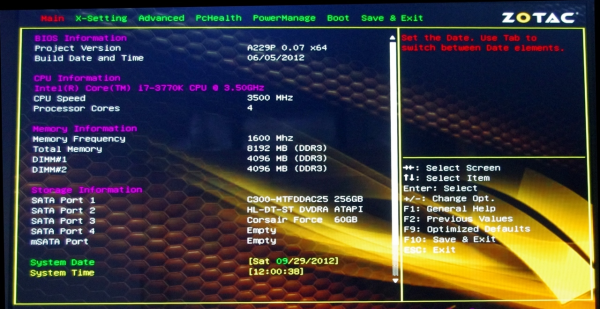

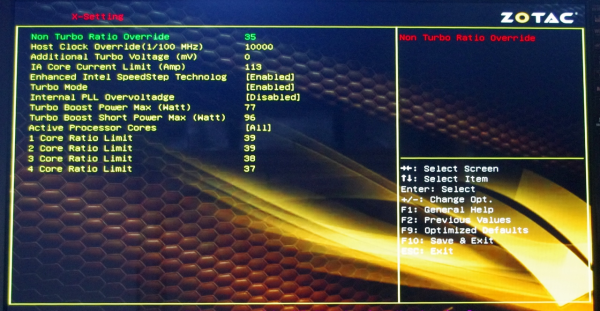
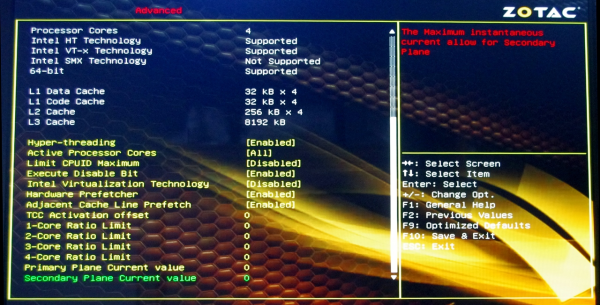
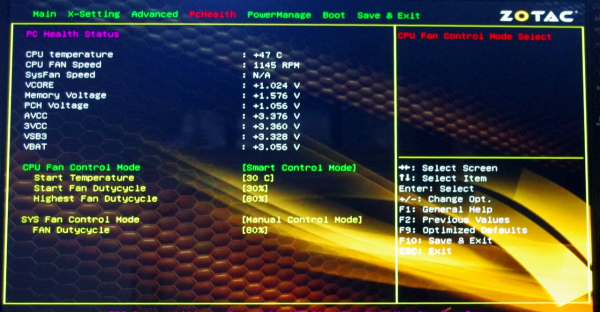
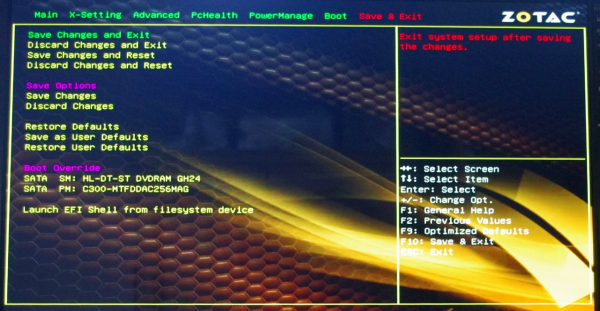














54 Comments
View All Comments
Bullwinkle J Moose - Monday, December 31, 2012 - link
Hey yeah, Ian haz a good pointThat Crappy Gigabyte H61n-USB3 doesn't have Chipset USB3
But it does however boot just fine to a USB3 Windows to go drive at USB3 speeds
It also boots to Linux and XP due to the Non-Locked down Bios so we wouldn't want that either would we
and it takes a full 9 seconds to boot XP compared to the super de duper fast 7 second Windows 8
So we should spend more money and get locked into a closed system
After all, that is the future!
Limitations are fun so be happy as we lock down the Internet as well
After all, there are scarey Monsters out there
A man has to know his limitations
Clint Eastwood
Bullwinkle J Moose - Monday, December 31, 2012 - link
Ian haz a good point about the memory tooThat Gigabyte H61 board only takes up to 16GB of RAM
How much do these Z77 boards take by the way?
Was it this site or Maximum PC where the reviewers stated that in everyday use, you will notice no difference in speed between Sata 2 & 3 when you are using the latest and greatest SSD so I probably don't need the RAID capability on my H61 either
Keep up the good work Ian
Death666Angel - Wednesday, January 2, 2013 - link
It seems that someone just discovered sarcasm. Good for you!mczak - Monday, December 31, 2012 - link
H61 is not limited to one single sided DIMM per channel, double sided are just fine. It only accepts one per channel (at least it's specced that way) but since none of these mini-ITX boards have more than two memory slots this wouldn't matter at all here (max memory is still 2x8GB regardless).Frankly I'm not sure losing PCIe 3.0 is a big deal with mini-itx boards in any case but either way it isn't exactly true there are h61 boards supposedly supporting this (as it's got nothing to do with the chipset anyway all the pcie 3.0 signals coming directly from the cpu, though it would require bios support).
This leaves us with losing SATA 6 Gbps - this might indeed make some minimal difference in real world, provided you use a SSD and not a HD.
The major point imho (aside from overclocking) would be missing USB 3.0, which obviously makes a big difference when using external harddisks etc. Granted that could be done with separate usb controller but probably not a good idea since space is limited.
H61 IIRC also will lose the possibility of using 3 display outputs simultaneously. Maybe something like H77 would make more sense for mini-ITX as it pretty much only loses overclocking (plus the ability to split the 16 x pcie 3.0 lanes into 2x8 though I guess this has nothing to do with the chipset itself really, but in any case it won't be missed on mini-itx). So if you don't want to overclock, you wouldn't miss anything at all with H77 on a mini-itx board.
Etern205 - Saturday, January 5, 2013 - link
I also notice that as well, most sites will only review Z77 mITX boards instead of H61 or H77. Not all will need a Z77, Z77 is mostly for enthusiast or for those who are into the technical stuffs. For the average Joe or Jane any mITX board will do. If you tell them it's H61 or Z77, they probably won't care too much on the difference.piroroadkill - Wednesday, January 2, 2013 - link
You can't easily upgrade the chipset later. With a small up-front investment, you get the full feature set, and why not?Bullwinkle J Moose - Sunday, January 6, 2013 - link
Oh Boo Hoo, I can't easily upgrade to an overclocking chipset or void the warranties of my hardware componentsI am just stuck with a totally stable system
Boo Hoo
How can I possibly break this ?
What has the World become ?
Poor me
Boo Hoo
Bullwinkle J Moose - Sunday, January 6, 2013 - link
Why not?Because the H61 is exactly what I wanted
and anything else is NOT !
can you hear me now?
EVGA KINGPIN - Friday, November 19, 2021 - link
I still use my Z77 FTW board , have had it running without turning it off since 2015. evga is the best ,also my EVGA GTX 980 KINGPIN is still running strong,,,thanks EVGA for quality products, JRTsherlockwing - Monday, December 31, 2012 - link
Where is the Gigabyte?